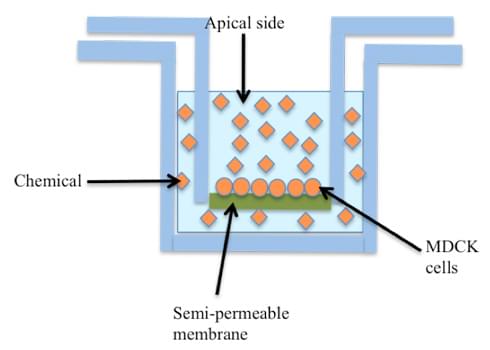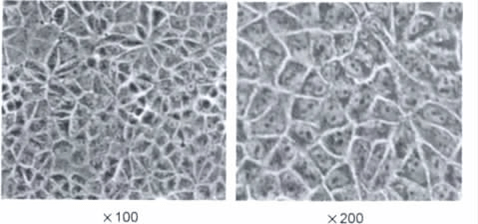MDR1-MDCK Permeability Assay
Creative Bioarray is a reliable MDR1-MDCK permeability assay provider. After years of development, Creative Bioarray has become an expert in drug discovery and development. Using a highly automated approach, we offer this in vitro ADME screening service to determine drug permeability.
MDR1-MDCK permeability assay introduction
- In vitro permeability assay
Intestinal drug absorption is one of several factors that determine the success of oral drug products and their efficacy, toxicity, and pharmacokinetics. Therefore, models that predict intestinal drug absorption are becoming increasingly important in early drug development to accelerate identifying promising or problematic compounds. Since permeability is one of the factors that affect drug absorption, it has become the focus of several experimental models available to researchers. The use of cell culture provides a method for predicting drug permeability by using the cell monolayer in the dual-chamber diffusion system to simulate the process of drug entering the blood from the intestinal lumen. Among them, the Caco-2 model and MDR1-MDCK model are widely used.
- Why MDR1-MDCK?
An investigational drug should be evaluated in vitro to determine whether it is a potential substrate of P-glycoprotein (a well-recognized efflux transporter in many tissues and organs such as the brain, kidney, and intestine). MDR1-MDCK permeability assay is one of the drug absorption screening methods. This method uses the MDR1-MDCK cell line, a combination of Madin Darby Canine Kidney (MDCK) cells, and the MDR1 gene to encode the efflux protein, P-gp. The MDR1-MDCK permeability assay is a valuable tool to identify and characterize P-gp substrates and inhibitors, and it can help understand the mechanism of drug efflux and highlight early potential issues with drug permeability at an early stage.
Compared to Caco-2 cells, MDCK cells can form a cell monolayer with tight junction much faster, with lower transporters expression and metabolic activities.
Key Features
- High stability and reproducibility
- Compatible with buffers containing organic solvents
- Faster cell growing time
- Lower TEER values
- Can be used as an in vitro blood-brain barrier (BBB) model
Brief Protocol
Similar to the Caco-2 assay, the MDR1-MDCK assay also detects the permeation efficiency of compounds from apical to basolateral (A→B), or from basolateral to apical (B→A) in a system with the MDCK cell layer as the filter membrane by Transwell assay. The apparent permeability coefficient (Papp), efflux ratio, and %recovery are calculated to evaluate the compound's permeation.
 Figure 1. The schematic diagram of the MDR1-MDCK model
Figure 1. The schematic diagram of the MDR1-MDCK model
The MDCK experimental protocol is as follows:
1) MDCK (Madin-Darby Canine Kidney) cells are seeded on a Multiscreen plate to form a confluent monolayer for four days
2) After washing with HBSS buffer, test compounds are added to the apical side of the monolayers, together with leakage indicator Lucifer Yellow
3) Leakage of monolayer (Lucifer Yellow) is determined by fluorescent reader
4) Basolateral samples in the receiving plate are transferred to a fresh plate for LC/MS/MS analysis
Assessment of cell monolayer integrity
Lucifer yellow rejection assay is applied to determine the cell monolayer integrity. Buffers are removed from both apical and basolateral chambers, followed by the addition of Lucifer yellow in transport buffer and transport buffer in apical and basolateral chambers, respectively.
Study example
- Preparation of MDR1-MDCK Cells
 Figure 2. Morphology of MDR1-MDCK cells.
Figure 2. Morphology of MDR1-MDCK cells.
- Method and Results
Compounds are applied to the apical or basolateral side of the cell monolayer. The apparent permeability and efflux ratio of the test compounds was determined in duplicate. Compounds were quantified by LC-MS/MS analysis based on the peak area.
| Case study-Permeability Results of Test Compounds in MDCK assay | |||||||
| Compound | Mean Papp (10-6 cm/s) | Efflux Ratio | Mean Solution Recovery % | Classif. | Note | ||
| A to B | B to A | A to B | B to A | Papp | |||
| Nadolol | 0.59 | ND | ND | 88.31 | ND | Low | Low Permeability marker |
| Metoprolol | 18.11 | ND | ND | 86.81 | ND | High | High Permeability marker |
| Digoxin | 0.25 | 11.28 | 45.53 | 91.42 | 93.19 | Low | P-pg substrate |
Notice: %Recovery = 100 × [(Vr × Cr) + (Vd × Cd)] / (Vd × C0). %Recovery = 100 × [(Vr × Cr) + (Vd × Cd)] / (Vd × C0).where: dQ/dt: the permeability rate. A: the surface area of the cell monolayer. C0: the initial concentration in the donor compartment. Vr: the solution volume in the receiver chamber. Vd: the volume in the donor chambers. Cd and Cr: the final concentrations of transport compound in donor and receiver chambers, respectively | |||||||
Quotation and ordering
Creative Bioarray offers a consistent and cost-effective MDR1-MDCK permeability assay service. With multiple specialists and years of experience in this area, we guarantee you quality data and customized results to meet your project requirements. We also provide stable MDR1-MDCK cell lines, and you can order this product. If you have additional requirements or questions, do not hesitate to contact us. Our specialists in this area will help you solve your problems, and Creative Bioarray will be your best partner in the field.
References
- Volpe, D. A. Variability in Caco-2 and MDCK Cell-Based Intestinal Permeability Assays. Journal of Pharmaceutical Sciences, (2008), 97(2), 712-725.
- Hellinger, É.; et al. Comparison of brain capillary endothelial cell-based and epithelial (MDCK-MDR1, Caco-2, and VB-Caco-2) cell-based surrogate blood–brain barrier penetration models. European Journal of Pharmaceutics and Biopharmaceutics, (2012),82(2), 340-351.

